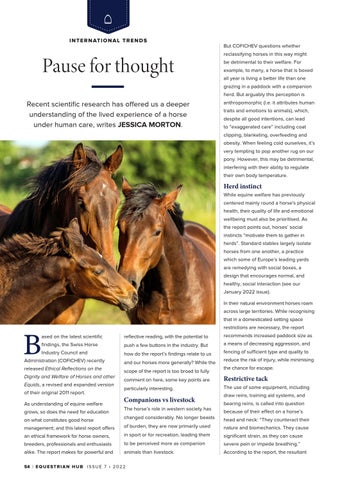I N T E R N AT I O N A L T R E N D S
Pause for thought
But COFICHEV questions whether reclassifying horses in this way might be detrimental to their welfare. For example, to many, a horse that is boxed all year is living a better life than one grazing in a paddock with a companion herd. But arguably this perception is
Recent scientific research has offered us a deeper understanding of the lived experience of a horse under human care, writes JESSICA MORTON.
anthropomorphic (i.e. it attributes human traits and emotions to animals), which, despite all good intentions, can lead to “exaggerated care” including coat clipping, blanketing, overfeeding and obesity. When feeling cold ourselves, it’s very tempting to pop another rug on our pony. However, this may be detrimental, interfering with their ability to regulate their own body temperature.
Herd instinct While equine welfare has previously centered mainly round a horse's physical health, their quality of life and emotional wellbeing must also be prioritised. As the report points out, horses’ social instincts “motivate them to gather in herds”. Standard stables largely isolate horses from one another, a practice which some of Europe’s leading yards are remedying with social boxes, a design that encourages normal, and healthy, social interaction (see our January 2022 issue). In their natural environment horses roam across large territories. While recognising that in a domesticated setting space
B
restrictions are necessary, the report
ased on the latest scientific
reflective reading, with the potential to
recommends increased paddock size as
findings, the Swiss Horse
push a few buttons in the industry. But
a means of decreasing aggression, and
Industry Council and
how do the report’s findings relate to us
fencing of sufficient type and quality to
Administration (COFICHEV) recently
and our horses more generally? While the
released Ethical Reflections on the
scope of the report is too broad to fully
Dignity and Welfare of Horses and other Equids, a revised and expanded version of their original 2011 report. As understanding of equine welfare grows, so does the need for education
reduce the risk of injury, while minimising the chance for escape.
comment on here, some key points are
Restrictive tack
particularly interesting.
The use of some equipment, including
Companions vs livestock
draw reins, training aid systems, and
The horse’s role in western society has
bearing reins, is called into question because of their effect on a horse’s
on what constitutes good horse
changed considerably. No longer beasts
head and neck: “They counteract their
management; and this latest report offers
of burden, they are now primarily used
nature and biomechanics. They cause
an ethical framework for horse owners,
in sport or for recreation, leading them
significant strain, as they can cause
breeders, professionals and enthusiasts
to be perceived more as companion
severe pain or impede breathing.”
alike. The report makes for powerful and
animals than livestock.
According to the report, the resultant
54 | E Q U E S T R I A N H U B I S S U E 7 • 2 0 2 2






















